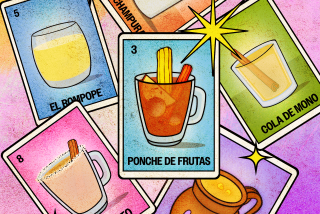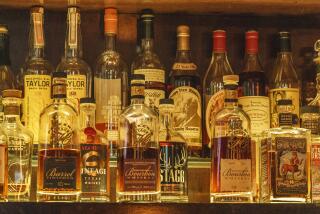Refined Rum Cools Off Tourists in Puerto Rico
- Share via
SAN JUAN, Puerto Rico — Visitors to this island are usually welcomed with a cooling concoction made with the native brew: rum.
Apt, since the island is the world’s major rum-maker and the tour of the Bacardi Distillery, offering tastings and access to a discount shop for rum and bar accessories, is among Puerto Rico’s most popular and entertaining attractions.
Nobody knows for sure just where or when the first rum was made. But the liquor’s history on Puerto Rico goes back almost 500 years to the time of Christopher Columbus.
On his second voyage to the West Indies, Columbus brought and planted sugar cane, which soon became the region’s top crop. Ponce de Leon introduced sugar cane to Puerto Rico when he was appointed governor of the island in 1508.
Whether sugar cane juice was first distilled into rum by conquistadors or by pirates is a matter of conjecture; some say it was the Spanish, others claim it was the English.
Early rum was a distant ancestor of the smooth, light, more refined drink we enjoy today. To get an idea of rum’s rough, fiery origins, one need only consider the brand names under which it was labeled: Kill-Devil, Whistle-Belly Vengeance, Rattle-Skull and Bounce and Sling.
Puerto Rico took the lead in modern, quality rum-making by establishing production standards. The main force has been the Bacardi family, distillers who refined their product and marketing techniques to perfection.
It began when Don Facundo Bacardi Maso, a wine expert, emigrated in 1830 from Barcelona to Santiago, Cuba, where he began making rum for his own amusement and consumption.
Friends who sampled his smooth, mellow product urged him to produce it commercially. In 1862, he purchased a small distillery and began making Bacardi rum, known as “Bat Rum” because the distillery was inhabited by a colony of fruit bats. The bat is still Bacardi’s logo.
Bacardi got widespread name recognition because of two drinks associated with it: the Bacardi Daiquiri, created in 1896 by an American mining engineer and named after Cuba’s copper mines where he worked, and Cuba Libre, first mixed in 1900 by Teddy Roosevelt’s Rough Riders, who blended a new soft drink, Coca-Cola, with their Bacardi.
In 1936 the company, then headed by Bacardi’s three sons, expanded to Puerto Rico, a strategic ploy designed to eliminate U.S. customs duties on liquor imported from Cuba.
Eventually, Bacardi became one of Puerto Rico’s biggest employers and a powerful force in the island’s development. A new distillery, opened in 1958 on 127 acres of reclaimed swampland in the San Juan suburb of Captain, became Bacardi’s headquarters when Fidel Castro took over the Cuban plant in 1960.
Local guide companies offer Bacardi Distillery tours for $25 per person, including motor-coach transportation from hotels or dockside to the plant and back. But there is really no need to book these.
You can get to the Distillery on your own by taking the Catano Ferry (10 cents per person), then hailing a publico (shared taxi, $2 per person each way) that drops you off directly in front of the Bacardi plant. Just ask the guard at the gate for the tours, which are free.
Tours begin at the Bacardi bar, a huge, bat-shaped patio with small round tables and comfortable chairs. The bar pours unlimited quantities of sample-size servings of several varieties of Bacardi rum, and a variety of cocktails prepared from them.
There are basically three rums: white, gold or amber and anejo (aged) . Bacardi currently makes seven rums. Silver Label is a smooth, light, dry spirit with subtle aroma and flavor for daiquiris, martinis and tonic drinks. Amber Label is a smooth dark, dry spirit with more pronounced aroma and flavor, ideal for mixing with lemon-lime soda or ginger ale, or for serving on the rocks.
Bacardi Premium Black, smooth and very flavorful, mixes well with fruit juices and coladas . Bacardi Anejo, a blend of aged aromatic spirits, is best sipped neat or on the rocks. Bacardi Gold Reserve, top of the line, is the master blend of aged spirits and is best served in a snifter, neat or on the rocks.
Neither Bacardi 1873, an extra dry blend, nor Bacardi 151 Proof, used for flavoring fancy drinks and cakes, are sold on the mainland, but they may be sampled and bought in Puerto Rico.
At the Bacardi bar, which also serves soft drinks and juice, personal discretion determines how much rum any individual imbibes. Sometimes greedy guests don’t make it through the tour, which is a pity because it’s fascinating.
Leaving the bar, the tour sets out on a pleasant drive on an open bus around the pretty Bacardi gardens. First stop is the distillery building, where a guide leads the way through control rooms, around 20 huge vats filled with 50,000 gallons of fragrant fermenting molasses, past four six-story distilling towers of gleaming steel, and around tanks used for blending and countless white oak barrels in which rum is being aged.
The four-tower fractional distillation process is explained in English and other languages. In the first tower, the fermented liquid is heated to 220 degrees to remove water from the alcohol. The temperature in the second tower is 200 degrees to remove the aldehydes from the alcohol.
The third tower is set at 187 degrees to remove unwanted oils from the alcohol. In the fourth and final tower, the temperature is 170 degrees for final purification.
Visitors also tour the gleaming bottling and labeling plants that turn out 23,000 cases, or approximately 100,000 bottles, of rum per day. There is also a fine museum featuring an enormous trompe l’oeil mural about Bacardi’s history, painted in 1966 by Palmer Hill and Ronald Millard, two Greenwich Village artists.
Last is the shop, stocked with rum, bar accessories and other souvenirs at terrific prices. For example, the five-item combination gift pack, with two Silver Labels, two Anejos and one 151 Proof (one-liter bottles), costs $28.15. A five-pack with three Silver Labels and two Gold Reserves is $33.25.
A four-pack with one Silver Label, one Amber Label, one Premium Black and one Anejo (one-liter bottles), costs $22.60. There are two-packs: two Premium Black for $15.20, one Silver and one Premium Black for $12, one silver and one Amber for $8.50 or two Ambers for $8.50. A special Gold Reserve gift pack with two Bacardi logo snifters costs $11.25; Anejo with two snifters is $9.90. Bottles of 1873 (750 milligrams) sell for $6.50.
In addition, there are Bacardi ice buckets ($15.30), beach sheets with the bat logo or confetti patterns ($8.15), T-shirts ($4.50), carry bags ($8.35), Bacardi dominos ($5.65) and other souvenir items.
Of course, the Bacardi shop is not the only game in town. Bottles of rum can also be purchased at good prices at most supermarkets in Puerto Rico. For example, Selectos Capitol, a chain store in San Juan, sells Bacardi Silver Label for $4.19 per liter, Anejo for $7.69 per liter and Gold Reserve for $9.99 per liter, just slightly higher than at the Bacardi store.
This shop does not carry 1873 and 151 Proof, and was out of stock on Amber Label. But it did offer selections from several other Puerto Rican rum distilleries: Granado Dark for $4.25 per liter, Don Q for $5.00 per liter or $11.75 per half-gallon, and Ron del Barrilito’s two-star (aged 8 years) for $6.95 per liter and three-star (aged 12 years) for $7.70 per liter.
The airport duty-free shop offers Bacardi Silver and Amber Labels for $4.65 per liter, Anejo for $6.95 per liter, Gold Reserve for $9.75 per liter and Premium Black for $7.95 per liter.
Buy as much as you want without worrying about customs; Puerto Rico is part of the United States.
More to Read
Sign up for The Wild
We’ll help you find the best places to hike, bike and run, as well as the perfect silent spots for meditation and yoga.
You may occasionally receive promotional content from the Los Angeles Times.






